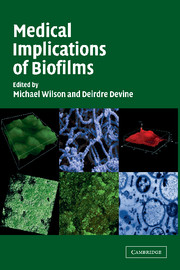Book contents
- Frontmatter
- Contents
- Preface
- List of Contributors
- PART ONE INTRODUCTORY CHAPTERS
- PART TWO BIOFILMS ON PROSTHETIC DEVICES
- 4 Animal Models of Orthopaedic Implant Infection
- 5 Intravascular-Catheter-Related Infections
- 6 Molecular Basis of Biofilm Formation by Staphylococcus epidermidis
- 7 Biofilm Complications of Urinary Tract Devices
- PART THREE ORAL BIOFILMS
- PART FOUR BIOFILMS ON SHEDDING SURFACES
- Index
- References
7 - Biofilm Complications of Urinary Tract Devices
Published online by Cambridge University Press: 23 November 2009
- Frontmatter
- Contents
- Preface
- List of Contributors
- PART ONE INTRODUCTORY CHAPTERS
- PART TWO BIOFILMS ON PROSTHETIC DEVICES
- 4 Animal Models of Orthopaedic Implant Infection
- 5 Intravascular-Catheter-Related Infections
- 6 Molecular Basis of Biofilm Formation by Staphylococcus epidermidis
- 7 Biofilm Complications of Urinary Tract Devices
- PART THREE ORAL BIOFILMS
- PART FOUR BIOFILMS ON SHEDDING SURFACES
- Index
- References
Summary
INTRODUCTION
The anatomy of the urinary tract, unfortunately, allows ready access by pathogens to the urethra and beyond when normal defences are breached. The potential for urinary tract infection (UTI) is considerably enhanced by the presence of an indwelling device such as a urethral catheter that provides a conduit to the bladder (Tunney, Jones, and Gorman, 1999). This allows not only the voiding of urine, but also the ingress of microorganisms that colonise the device material and adopt a biofilm growth mode. Such ‘device-related’ infection is a frequent occurrence in the urinary tract, requiring considerable time and resource in its management. It is estimated that over 40 per cent of nosocomial infections are related to the urinary tract (Nickel, Downey, and Costerton, 1989). Despite careful aseptic management, bacteriuria arises in approximately 50 per cent of patients within 10–14 days and in all those undergoing long-term catheterisation for management of urinary retention and incontinence by 28 days. Additional complications such as blocking encrustations, stone formation, pyelonephritis, and bladder cancer may also arise in patients with asymptomatic infection (Gorman and Tunney, 1997). The elderly are particularly prone to urinary device-related infection. Residents of nursing homes undergoing long-term catheterisation are three times more likely to receive antibiotics, be hospitalised, and die within a year than matched non-catheterised residents (Kunin, Chin, and Chambers, 1987).
The obstruction of urine flow in urinary devices by crystalline encrustation is an additional clinical complication.
- Type
- Chapter
- Information
- Medical Implications of Biofilms , pp. 136 - 170Publisher: Cambridge University PressPrint publication year: 2003
References
- 12
- Cited by



